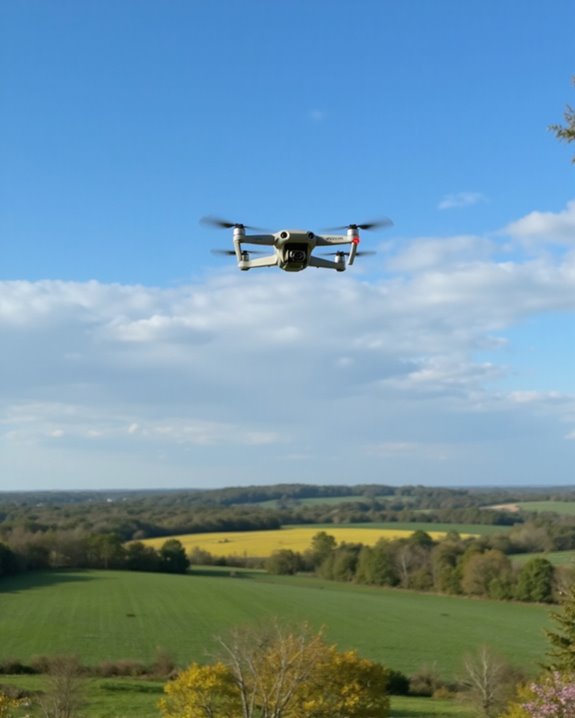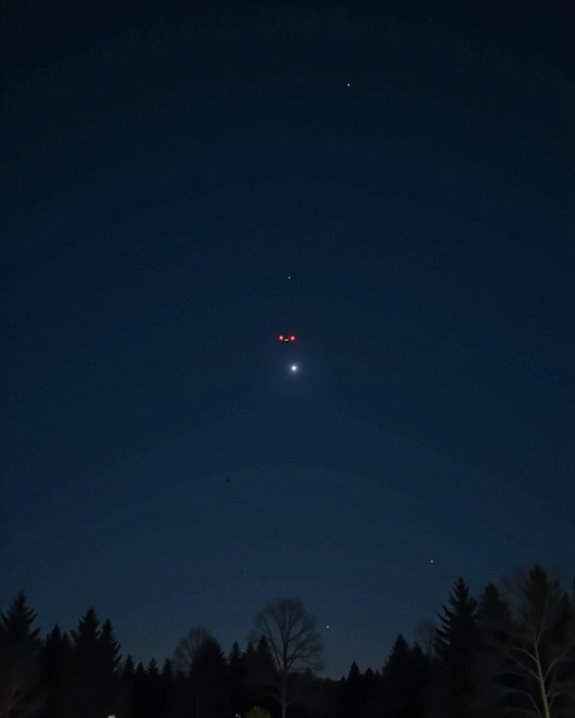The DJI Avata 2 offers convenient USB-C charging directly through the drone body, completing a full charge in 88 minutes. The original Avata, however, requires battery removal for charging. With the Two-Way Charging Hub, pilots can sequentially charge up to three batteries while monitoring status via LED indicators. Both models support fast charging with compatible USB PD adapters. Drone enthusiasts can maximize flight time by exploring various charging solutions that fit their specific adventure needs!
Key Takeaways
- Original DJI Avata requires battery removal for charging and cannot be charged directly on the drone.
- DJI Avata 2 supports 30W direct USB-C charging through the drone body without battery removal.
- Direct charging on the Avata 2 takes approximately 88 minutes for a full charge.
- The Avata 2’s LEDs indicate charging status when charging directly through the drone.
- Both models can use the Two-Way Charging Hub for more efficient sequential battery charging.
Direct Charging Capabilities of the DJI Avata 2
The DJI Avata 2 offers a convenient way to keep your drone powered up without removing the battery, thanks to its direct charging capabilities. Following Historical Evolution in drone design, the Avata 2 supports up to 30W charging power directly through the drone body—a feature drone enthusiasts have been craving for years! Market Trends show consumers want more flexibility in their tech, and DJI delivered.
Simply connect a USB-C charger to the drone’s port, and you’re good to go. While the direct method takes about 88 minutes for a full charge (compared to 45 minutes with the Two-Way Charging Hub), it’s perfect for quick top-ups between flights. The drone’s LEDs helpfully display charging status, so you’ll know exactly when you’re ready to take to the skies again! This is made even more convenient by the universal power source compatibility that allows charging from various USB power supplies like phone chargers and power banks.
USB-C Charging Options and Compatibility

Unlike the newer DJI Avata 2, understanding charging options for the original DJI Avata reveals some key differences worth noting. The original model doesn’t support direct USB-C charging on the drone itself, representing an interesting step in the standard evolution of drone charging technology.
While the drone requires battery removal for charging, many DJI accessories utilize USB-C connections for cross platform use. This means your DJI power adapters (up to 65W) can potentially charge other devices too! Fast charging protocols like USB PD greatly reduce wait times between flights. For best results, stick with DJI’s dedicated chargers rather than generic alternatives. Safety features such as overcharge protection are essential to ensure battery longevity and prevent damage during charging.
The Two-Way Charging Hub Advantage

Why struggle with individual battery charging when you can streamline the entire process? The DJI Avata 2 Two-Way Charging Hub offers a remarkably efficient solution for drone enthusiasts, allowing sequential charging of up to three Intelligent Flight Batteries without manual switching. Its durable construction guarantees longevity while maintaining a sleek, compact design that’s perfect for travelers and professionals alike!
The hub’s ecosystem integration truly shines when paired with DJI’s 65W Portable Charger, delivering a full battery charge in just 45 minutes. This clever device even features intelligent power accumulation, transferring juice from lower-powered batteries to those needing more charge. Beyond convenience, it transforms your battery management experience with its user-friendly interface and ability to charge external devices via USB—making it an essential companion for anyone serious about maximizing their drone flight time. The hub is especially valuable because a multi-battery charging hub enables simultaneous charging of three batteries, reducing downtime between flight sessions.
Charging Times and Power Requirements
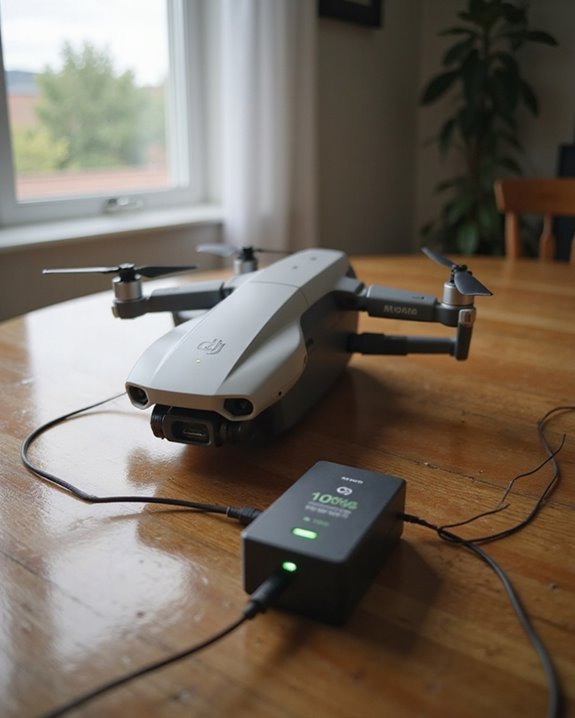
Efficient power management forms the backbone of uninterrupted drone flight sessions, especially with the DJI Avata’s demanding energy needs! The DJI 65W Portable Charger, when paired with the Two-Way Charging Hub, delivers a remarkably swift 45-minute charging time while maintaining ideal Voltage Levels throughout the process.
Alternative USB PD-compatible chargers can also juice up your batteries, though they might not match the efficiency of DJI’s recommended options. When choosing your power source, remember that faster charging typically means more Heat Generation—but don’t worry, the Two-Way Charging Hub incorporates intelligent management to keep temperatures in check. You can even charge batteries individually outside the hub if you’re in a pinch!
For pilots constantly on the move, car chargers and power banks supporting USB PD offer convenient alternatives to keep your adventures soaring!
Battery Management and Safety Features
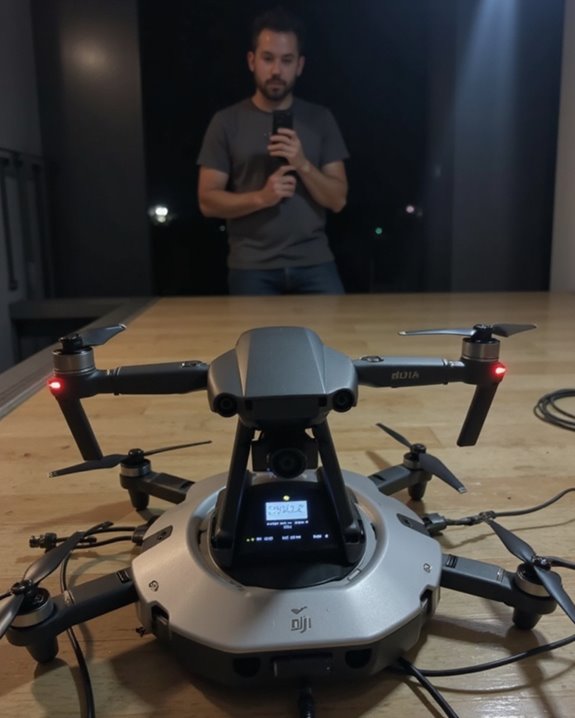
The DJI Avata’s revolutionary battery management system takes your flying experience beyond mere power supply to a thorough safety ecosystem! The intelligent Li-ion battery, featuring LiNiMnCoO2 chemistry, continuously monitors its status in real-time, allowing you to focus on capturing those perfect aerial shots without power anxiety.
Heat Management is a critical component, with the system’s normal moderate heat emission during auto-discharge periods protecting your investment. The DJI Pilot 2 app integrates seamlessly with the battery’s Health Monitoring features, giving you control over self-discharge settings that extend your battery’s lifespan. While you can’t charge directly on the drone (a deliberate safety choice!), the dedicated charging hub provides a controlled environment for your 2420 mAh powerhouse. Remember, proper battery care isn’t just about longer flights—it’s about safer ones too!
On-the-Go Charging Solutions for Drone Pilots
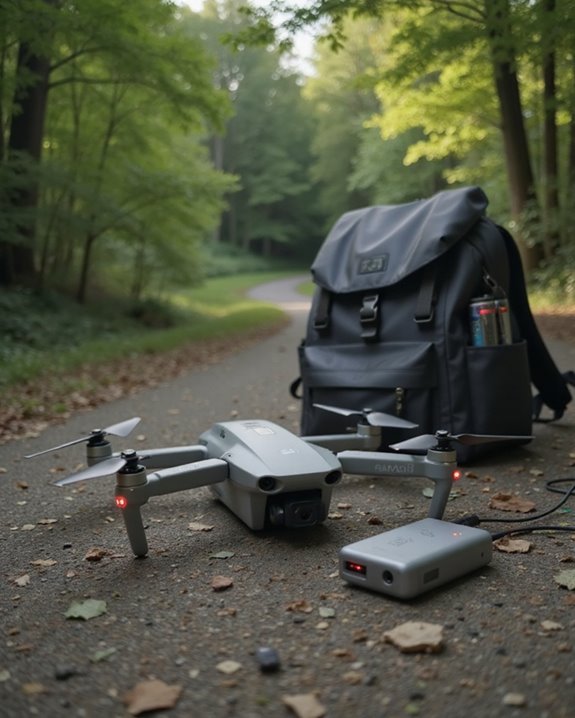
How often have you found yourself grounded during the perfect shooting conditions because of a dead battery? Fear not, as modern Mobile Chargers have revolutionized the way drone pilots maintain power in the field!
USB-C PD compatible chargers paired with high-capacity power bricks offer quick battery replenishment without hunting for wall outlets. The DJI 65W Portable Charger, a drone pilot’s best friend, can fully charge an Avata battery in just 45 minutes when used with the Two-Way Charging Hub. For truly Remote Power needs, 95W car chargers keep your drone ready during road trips, while PD-compatible power banks serve as backup power stations. The versatility doesn’t stop there – these solutions can simultaneously charge your controllers and goggles too, ensuring your entire flight kit stays mission-ready!
Frequently Asked Questions
Can I Charge the Avata 2 With a Power Bank?
The Avata 2 can use power banks for outdoor charging if they support USB Power Delivery protocols with sufficient wattage. These backup sources must deliver adequate power for efficient battery charging during field operations.
Will Charging the Drone Directly Drain Its Internal Components?
Like a fish gasping out of water, direct drone charging could impact battery longevity and accelerate component wear. The Avata 2 requires battery removal for charging to protect its internal electronics from potential damage.
Does the Charging Hub Work Without Main Power?
The charging hub requires an external power source to function and does not have Hub Backup capabilities. It lacks Power Independence, necessitating connection to either main power or a portable power source like the DJI 65W Portable Charger.
Can I Use Third-Party USB-C Cables for Charging?
Yes, third-party USB-C cables can be used for charging DJI Avata, but they must support PD fast charging protocol. Cable compatibility is vital, and using low-quality cables presents safety risks to the drone and charger.
How Does Cold Weather Affect Charging Time and Efficiency?
While summer promotes ideal charging, cold weather greatly hampers battery efficiency. Low temperatures slow chemical reactions within lithium-ion batteries, increasing charging times and potentially reducing overall capacity until the battery warms up.



